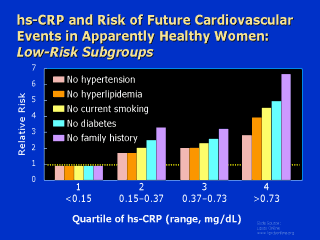 |
These data begin
to help us to understand why certain apparently low-risk groups nonetheless suffer MI and
stroke. Among specific subgroups of middle-aged women whom most of us would consider at
very low risk, i.e., no evidence of hypertension, no hyperlipidemia, nonsmokers, no
diabetes, and no family history of atherosclerotic disease, as the level of CRP increased
from low-normal to high-normal in all of these low-risk subgroups, so too did the future
risk of having a vascular event. These data fit with our hypothesis that plaque
instability is essentially what the inflammatory response is dictating: even with small
amounts of atherosclerosis, individuals with a propensity for plaque rupture and hence an
elevated level of the CRP response seem to be at highest vascular risk. Reference:
Ridker PM, Buring JE, Shih J, Matias M, Hennekens CH. Prospective study of C-reactive
protein and the risk of future cardiovascular events among apparently healthy women.
Circulation 1998;98:731-733.
WebsiteRidker PM et al. Circulation
1998;98:731-733. |
